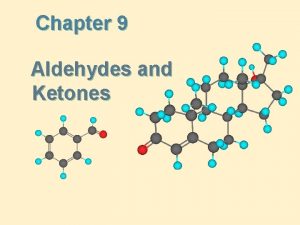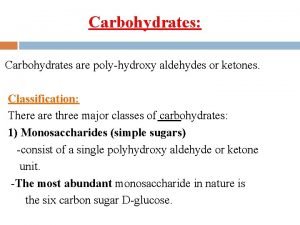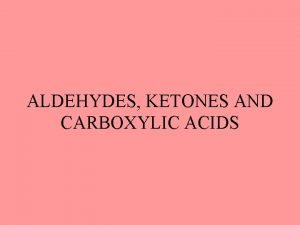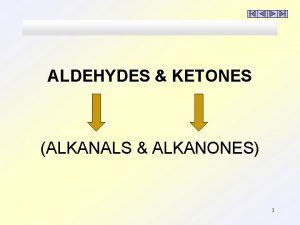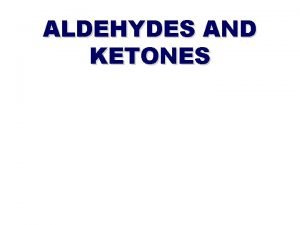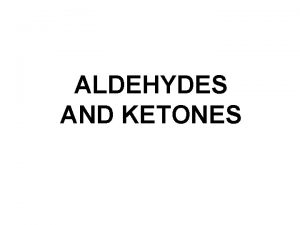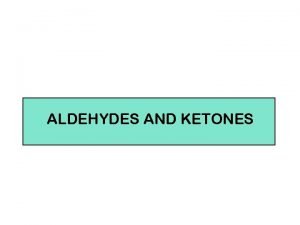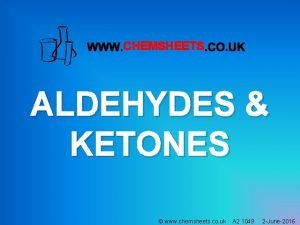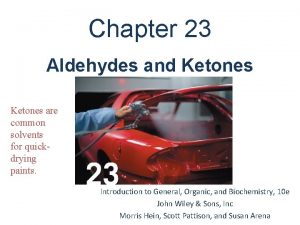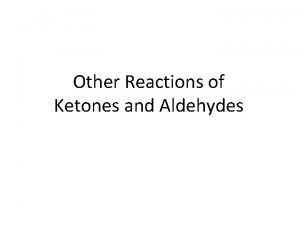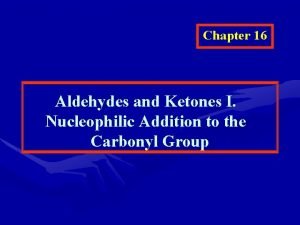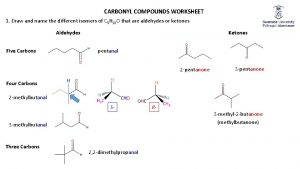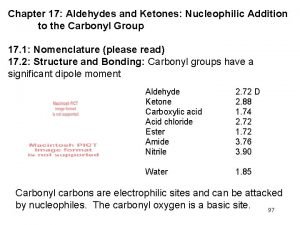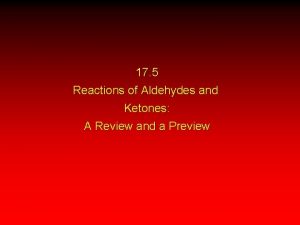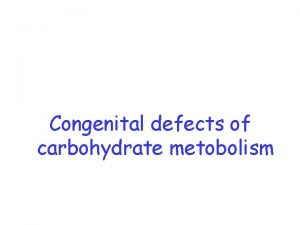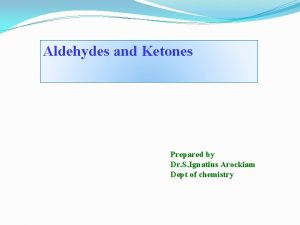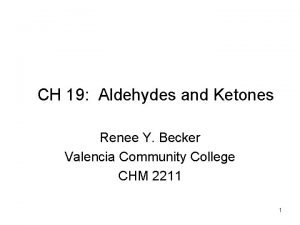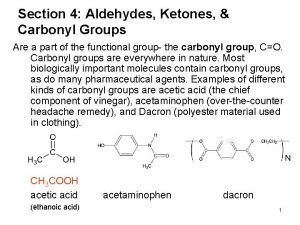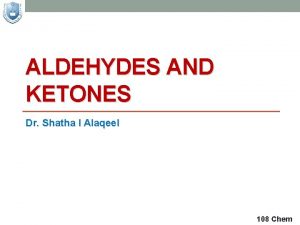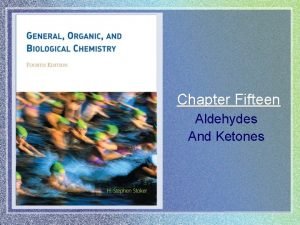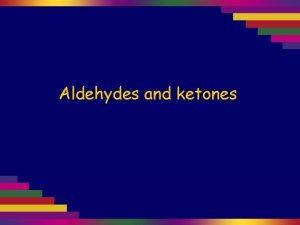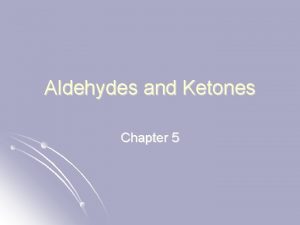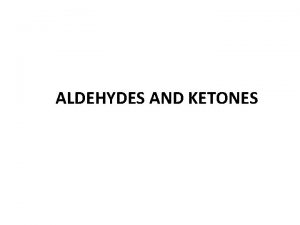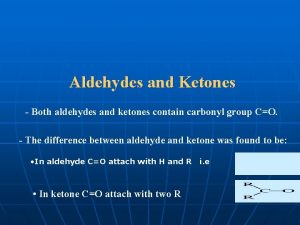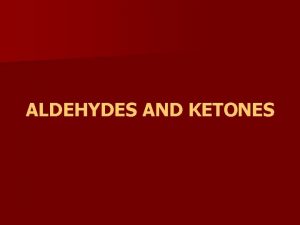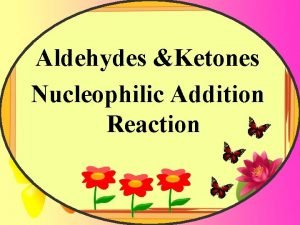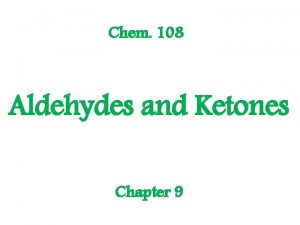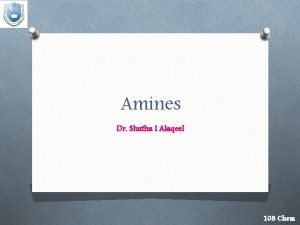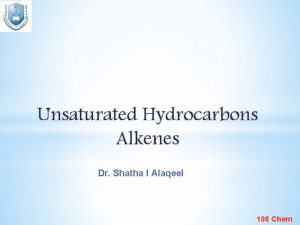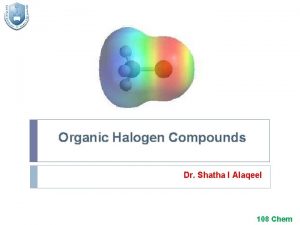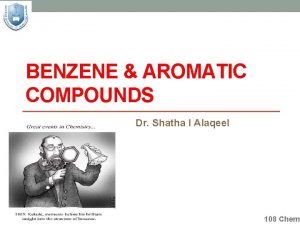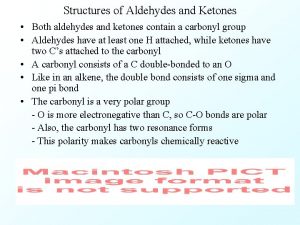ALDEHYDES AND KETONES Dr Shatha I Alaqeel 108





















- Slides: 21

ALDEHYDES AND KETONES Dr. Shatha I Alaqeel 108 Chem

2 Learning Objectives • Chapter eight discusses carbonyl compounds and by the end of this chapter the students will: ØKnow the structural differences between aldehydes and ketones ØKnow how to draw aldehydes and ketones Ø know the common and IUPAC nomenclature of aldehydes and ketones Ø Know the physical properties of aldehydes and ketones ØKnow how to synthesize an aldehyde or a ketone. Ø Know the different nucleophilic attack reactions at the carbonyl carbon. 108 Chem

3 ALDEHYDES: STRUCTURE AND NOMENCLATURE Aldehydes and ketones are organic compounds which incorporate a carbonyl functional group, C=O. The carbon atom of this group has two remaining bonds that may be occupied by hydrogen or alkyl or aryl substituents. If at least one of these substituents is hydrogen, the compound is an aldehyde RCHO or RCH=O. If neither is hydrogen, the compound is a ketone RCOR` (R and R`=alkyl or aryl). 108 Chem

4 Some Common Classes Carbonyl Compounds 108 Chem

5 Common Names of Aldehydes • In the common system, aldehydes are named from the common names of the corresponding carboxylic acid. • The ‘ic acid’ ending is replaced with ‘aldehyde’. • The aldehyde group is always at the end of a chain (terminal). formic acid acetic acid propionic acid butyric acid valeric acid caproic acid formaldehyde acetaldehyde propionaldehyde butyraldehyde valeraldehyde caproaldehyde 108 Chem

6 • Substituents locations are given using Greek letters ( , , , . ) beginning with the carbon next to the carbonyl carbon, the -carbon. -bromobutyraldehyde -hydroxyvaleraldehyde -phenylacetaldehyde • Aromatic aldehydes are usually designated as derivatives of the simplest aromatic aldehyde, Benzaldehyde p-Nitrobenzaldehyde o-Hydroxybenzaldehyde Salicylaldehyde p-Methoxybenzaldehyde Anisaldehyde 108 Chem

7 IUPAC Nomenclature of Aldehydes • Select the longest continuous carbon chain that contains the C=O group and replace the ending -e by the suffix -al • The CHO group is assigned the number “ 1” position and takes precedence over other functional groups that may the present such as –OH, C=C …… • If the CHO group is bonded to a ring, name the ring and add the suffix -carbaldehyde. 108 Chem

8 3 -bromobutanal benzenecarbaldehyde 4 -hydroxypentanal 2 -phenylethanal 3 -hydroxycyclopentanecarbaldehyde cyclohexanecarbaldehyde 108 Chem

9 Nomenclature of Ketones v. Common name: qlisting the alkyl substituents attached to the carbonyl group alphabetically, followed by the word ketone. As with aldehydes, substituents locations are given in common names using Greek letters ( , , , . ) beginning with the -carbon. v. IUPAC system: • Find the longest chain containing the carbonyl group, and change the -e ending of the parent alkane to the suffix -one. • Number the carbon chain to give the carbonyl carbon the lower number. Apply all of the other usual rules of nomenclature. • Ketones are just below aldehydes in nomenclature priority. • A ketone group is named as an ‘oxo’ substituent in an aldehyde. 108 Chem

10 Common Dimethyl ketone Methyl phenyl ketone Methyl vinyl ketone Acetone IUPAC Propanone Acetophenone Phenyl ethanone Diphenyl ketone Benzophenone 3 -Buten-2 -one Methyl isobutyl ketone -Chloroethyl isopropyl ketone (MIBK) Diphenylmethanone -Methoxypropyl phenyl ketone Cyclopentylpropanone 3 -Ethyl-2 -hydroxycyclohexanone 5 -Oxohexanal 108 Chem

11 PHYSICAL PROPERTIES OF KETONES AND ALDEHYDE • Aldehydes and ketones are polar compounds, Because the polarity of the carbonyl group. • Polarization of CO group creates Dipole-dipole attractions between the molecules of aldehydes and ketones, resulting in higher boiling points than nonpolar alkanes and ether. • aldehydes and ketones lower than alcohols Because Dipole-dipole attractions , are not as strong as interactions due to hydrogen bonding. • The lower aldehydes and ketones are soluble. Acetone, formaldehyde and acetaldehyde are miscible in water. 108 Chem

12 Preparation of Aldehydes and Ketones • Oxidation of alcohols • Ozonolysis of alkenes 108 Chem

13 • Hydration of alkynes • Friedel Grafts acylation 108 Chem

14 REACTIONS OF ALDEHYDES AND KETONES Nucleophilic Addition Reaction to the carbon-oxygen double bond. 1 -Reduction of carbonyl group Addition of metal hydrides: Formation of alcohols. 108 Chem

15 Reduction by hydride reagents, Lithium aluminium hydride Li. Al. H or Sodium boron hydride Na. BH 4. 1) Li. Al. H 4 / dry ether or Na. BH 4 2) H 3 O+ 108 Chem

16 • 2 - Addition of Grignard Reagents: Formation of alcohols 108 Chem

17 • 3 -Oxidation reaction • A) • B) Iodoform reaction: The reaction occurs in any aldehyde or ketone containing CH 3 CO. 108 Chem

18 • 4 - Addition of Hydrogen Cyanide: Formation of cynohydrins • 5 -Addition of acetylide ions: 108 Chem

19 6 - Addition of alcohols: Hemiacetal (new) Acetal (new) 108 Chem

20 • 7 - Addition of Ammonia and Ammonia Derivatives 108 Chem

21 Thank You for your kind attention ! Questions 108 Chem
 Aldehydes and ketones structure
Aldehydes and ketones structure Polyhydroxy aldehyde examples
Polyhydroxy aldehyde examples Naming of aldehydes
Naming of aldehydes What is an alkanone
What is an alkanone Aldehyde and ketone
Aldehyde and ketone Carbonyl vs ketone
Carbonyl vs ketone Structure of keton
Structure of keton Reactions of alcohols 2 chemsheets answers
Reactions of alcohols 2 chemsheets answers Chemical properties of ketones
Chemical properties of ketones Reactivity of ketones
Reactivity of ketones Aldehyde protecting group
Aldehyde protecting group Naming aldehydes and ketones worksheet with answers doc
Naming aldehydes and ketones worksheet with answers doc Aldehydes and ketones nucleophilic addition
Aldehydes and ketones nucleophilic addition Hydration of aldehydes and ketones
Hydration of aldehydes and ketones 360-108-108
360-108-108 Pvifad
Pvifad Galactosemia mechanism
Galactosemia mechanism Aldehyde and ketones
Aldehyde and ketones Nhr group name
Nhr group name Primary aldehyde
Primary aldehyde Aldehydes scary
Aldehydes scary Carbonyl carbon
Carbonyl carbon
